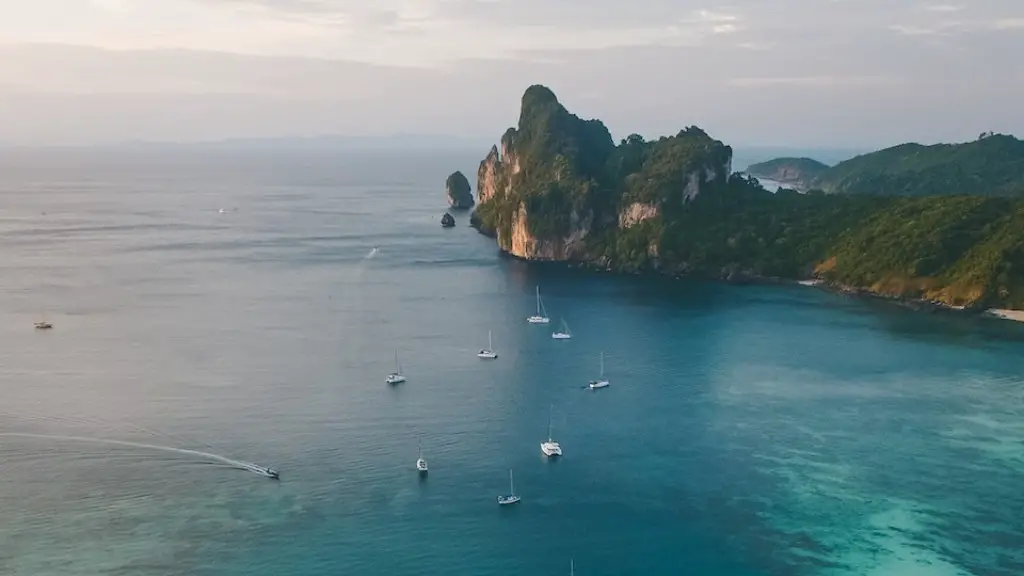The South China Sea is one of the world’s most contested and volatile regions. It is an area of immense economic and strategic importance, with over US$3 trillion in global trade passing through it each year. Located between several large countries, including the People’s Republic of China, Vietnam, the Philippines and Malaysia, the South China Sea is home to several small islands, including Paracel Islands, the Spratly Islands, Macclesfield Bank and Scarborough Shoal. It has become the site of multiple disputes and incidents, including military conflicts.
In recent years, China has been increasingly asserting ownership over much of the South China Sea, including most of the disputed Paracel Islands and the Spratly Islands. This has led to tension with other countries in the area, with China actively constructing artificial islands in the South China Sea and engaging in militarization of the area. The US Navy has conducted multiple “freedom of navigation” exercises to challenge China’s claims, and the US has sent aircraft carriers to the region to counter Chinese military operations.
In 2016, an international tribunal of the Permanent Court of Arbitration ruled in favor of the Philippines after it brought a case against China’s competing claims in the South China Sea. The tribunal found that China had violated the Philippines’ sovereign rights and illegally interfered with the Philippines’ traditional fishing rights in the area. It also rejected China’s historical claim to the majority of the South China Sea, including the Paracel Islands and Spratly Islands, ruling that these had never formed part of China’s traditional maritime boundary.
China rejected the ruling and asserted its continued claims to the area. It has responded to the ruling by increasing its military presence in the South China Sea, including naval exercises, air patrols and the construction of permanent military bases. China has also continued to build and militarize artificial islands in the disputed waters, in spite of protests from the US and other countries in the region.
The situation in the South China Sea has since become even more tense, with an increase in close military encounters between Chinese and US vessels in the area. In 2018, the US and China conducted a series of joint naval exercises in the South China Sea to seek to ease tensions and promote better understanding between the two militaries. Despite these efforts, the South China Sea remains contested and potentially volatile.
Chinese Claims
The Chinese government’s claims to the South China Sea derive from the so-called “nine-dash line” drawn on Chinese maps. This line demarcates an area of mainly Chinese control stretching from the coast of mainland China all the way down to the edges of the Philippine archipelago, encompassing a large portion of the South China Sea. The nine-dash line is a relatively recent construct and is not based on any legal or historical basis.
China’s continued assertion of the nine-dash line is a source of considerable friction with other countries in the region. China has used the claim to acquire control of resources and land within the area, and to prevent other countries from utilizing the resources within it. China’s construction of artificial islands in the disputed areas has been seen as a further attempt to solidify its control over the region.
China has consistently maintained that its claims to the South China Sea are based on historical and legal rights, citing long-standing territorial claims, historical titles and ancient documents as evidence. China has accused foreigners of “creating trouble” in the region and has accused the US of interfering in its “internal affairs.” While much of the international community has rejected China’s claims, there is no international legal or political resolution to the dispute.
Vietnamese Claims
Vietnam, like the Philippines and Malaysia, has competing claims in the South China Sea, including claims to energy and fishing resources in the area. Vietnam has at times been in direct conflict with China, engaging in skirmishes over fishing and oil exploration activities in the contested waters. Vietnam has also accused China of infringing on its sovereignty and has filed a number of legal cases against Chinese companies in the disputed waters.
In 2013, Vietnam and China engaged in a tense standoff over the placement of an oil rig in waters close to the Paracel Islands, an archipelago claimed by both countries. The incident led to a number of anti-China protests in Vietnam and increased tension between the two countries. In 2014, Vietnam and China reached an agreement to resolve the dispute, with both parties agreeing to engage in peaceful negotiations to settle their differences.
In spite of this agreement, tensions between Vietnam and China remain high, with Vietnam strongly rejecting Chinese claims of sovereignty over the South China Sea. Vietnam has called on its fellow ASEAN members to unite in opposition to China’s assertions of sovereignty, and has urged China to adhere to international law and the United Nations Convention on the Law of the Sea. In recent years, Vietnam has also claimed rights to a number of small isolated islands in the South China Sea.
Philippines Claims
The Philippines has long been involved in disputes over the South China Sea, and has consistently opposed Chinese claims to the region. In 2013, the Philippines brought a case against China to the Permanent Court of Arbitration, claiming that China had violated its sovereign rights by interfering with its rights to fish and explore for energy resources in the South China Sea. The tribunal found in favor of the Philippines, ruling that China had violated the country’s sovereign rights and had not made a valid claim to the primarily islands in the region.
In response to the ruling, the Philippines has sought to assert its rights to its exclusive economic zone, as outlined in the United Nations Convention on the Law of the Sea, and to counter China’s claims of sovereignty over the South China Sea. The Philippines has called on China to abide by the ruling of the tribunal, and has advocated for a multilateral approach to addressing the dispute. In 2017, the Philippines and China held a joint exercise in the South China Sea, and in 2018, the two countries signed a joint statement pledging to cooperate and resolve their territorial disputes peacefully.
ASEAN Claims
The ASEAN countries, including the Philippines, Vietnam, Malaysia and Brunei, have united to oppose China’s claims in the South China Sea. While the ASEAN countries have approached the dispute with China in a unified manner, they have also experienced tensions between themselves, as many countries within the bloc have overlapping claims to the region. In recent years, though, the countries have taken steps to mitigate these disputes, signing a Memorandum of Understanding in 2017 to strengthen peace and stability in the region.
The ASEAN countries have also sought to engage China in direct negotiations over their competing claims in the South China Sea. In 2017, the countries signed a joint agreement to cooperate under a Code of Conduct for resolving their differences, though the negotiations have yet to result in any concrete resolutions. The ASEAN countries have also sought to engage the US in negotiations, in the hopes that the US’s position as an outside power will be beneficial in resolving the dispute.
US Claims
The US has been involved in the South China Sea dispute since the early 2000s, when it became involved in the dispute between China and the Philippines. The US has continually sought to assert its influence over the region, with the Navy regularly sailing vessels close to Chinese-controlled islands to assert the right of “freedom of navigation.”
The US has accused China of engaging in aggressive military action in the South China Sea, and has encouraged other countries in the region to oppose China’s presence in the area. In 2018, the US and China held joint naval exercises in the South China Sea, and in 2019, the US and China issued joint statements pledging to cooperate and resolve their differences peacefully. Despite these efforts, tensions in the region remain high.
Conclusion
The South China Sea remains one of the most hotly contested pieces of international waters, with China and a number of other countries competing for control of the area and its resources. China has repeatedly asserted its rights to the region, and has engaged in a number of activities to strengthen its presence. Vietnam, the Philippines and other ASEAN countries also have competing claims to the region, and have sought to engage China in peaceful discussions to resolve their differences. The US has sought to increase its influence in the area, though it has yet to find a resolution to the dispute.




